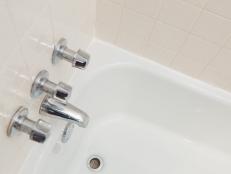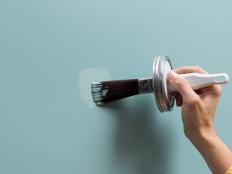How to Install Gutters
Gutters protect your roof and foundation by carrying excess rainwater away from the perimeter of your house. Many ranch-style homes built in the '50s and '60s have low-sloping roofs and were built without gutters. To correct such a situation, follow these instructions:
Materials and Tools:
guttering of your choice, including end caps, downspout pieces and couplers
fastening brackets with hardware
chalk line
measuring tape
string
string level
caulk gun
silicone sealant
hammer
drill with bits
tin snips
sheet-metal screws or rivet gun with rivets
hacksaw
safety glasses
Steps:
These steps cover just the basics of gutter installation; you'll need to modify them to fit your specific application. The main thing to remember is that proper measurements are key. The various pieces necessary to completing a gutter system (such as couplers, downspouts and end caps) will add to the overall length, so account for them when measuring and cutting your gutter pieces.
1. To determine how much guttering you need, measure the total length of the horizontal fascia boards under your roofline. Pay special attention to inside and outside corners so you can calculate for them accordingly.
2. At one of the horizontal fascia boards, identify the corner where you want to install the downspout. At the other end, drive a nail about halfway into the fascia board about 1½ inches below the roof edge and 1½ inches from the end of the board. This will serve as a beginning reference point.
3. Tie a string to the nail and stretch it to the corner where you plan to install the downspout. Use a string level to make a level reference mark 1½ inches below the roof edge and 1½ inches from the end of the board.
4. Measure the distance between the two points. This is how long your gutter assembly, including couplers and downspout pieces, needs to be.
5. Your gutter will need to slope downward ¼-inch for every 10 feet in length. For example, assume that the distance between the two reference points is 30 feet. Divide 30 feet by 10 feet to get 3; then multiply the 3 by ¼-inch to get ¾-inch. Place another reference mark ¾-inch below the previous reference mark on the downspout end of the fascia. The resulting slope will help the rainwater drain toward the downspout.
6. Snap a chalk line along the slope between the first and third reference marks.
7. Cut guttering to length using tin snips. If it takes two or more pieces to achieve the length you need, you'll have to use a coupler to join the pieces. Remember to account for the width of the coupler and any downspout pieces when cutting your gutter pieces to length.
8. Dry-fit the pieces, including end caps, and measure the length. Make any adjustments to ensure that you have the proper length of guttering.
9. Take the assembly apart, caulk all the joints with silicone sealant and reassemble the gutter.
10. Attach the fastening brackets to the fascia board with the hardware provided. Align the tops of the brackets with the chalk line.
11. Lift and snap the gutter into place inside the brackets. Secure the gutter with the remaining part of the bracket.
12. After all your guttering is in place, assemble your downspout(s). You may need to join several elbow pieces to reach from the downspout gutter piece around the underside of your roof overhang and back to the corner of your home (or whatever surface you will attach the downspout to). Cut the downspout pieces with a hacksaw or tin snips, and join them using sheet-metal screws or a rivet gun and rivets. Note: If you use a rivet gun, dry-fit the pieces together and drill pilot holes through both layers at once. Remember to wear safety glasses while drilling. Then insert the rivet into the hole and use the rivet gun to join the pieces together.
13. Put the downspout in place and secure it to a support beam or directly to the side of your home using aluminum straps and whatever screws necessary for the exterior of your home.













































